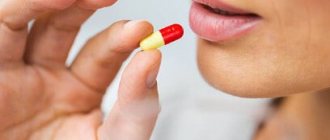11.04.2017
Thrush is a disease that is caused by an excessive amount of fungus Candida albicans in the body.
In the microflora of a healthy person, everyone has these yeasts and coexist with beneficial bacteria without causing discomfort. When favorable conditions arise, fungi begin to actively multiply, causing burning, itching and other symptoms.
The main causes of candidiasis:
- changes in hormonal levels and a decrease in the body's defenses (often causes thrush during breastfeeding and pregnancy);
- long-term use of antibiotics;
- vitamin deficiency;
- neglect of hygiene standards;
- hypothermia, stressful situation;
- wearing synthetic underwear.
Treatment of thrush during breastfeeding
A doctor can choose a cure for thrush after a thorough examination, assessment of the woman’s condition and an accurate diagnosis. Therapy may include oral tablets or a topical agent (ointments, suppositories).
Self-medication is unacceptable; it is fraught with complications for mother and baby. It is important to take into account that any suppositories can cause side reactions in the form of itching and burning, but after 2 days such symptoms disappear. If the local remedy copes well with the task, you can notice an improvement in the condition already on day 2.
If vaginal tablets are prescribed, you should not take them. This tablet is placed in the vagina and pre-soaked in water. Listed below are popular remedies that are prescribed during breastfeeding.
Natamycin (pimafucin) is a popular treatment for thrush. The drug is available in the form of tablets, suppositories, and cream. For thrush in the vagina, treatment with suppositories is prescribed, the course is up to 6 days. The medicine is an antibiotic with an antifungal effect. It is highly effective against candidiasis; the drug is safe during pregnancy and breastfeeding.
Sertaconazole is the active ingredient in cream and suppositories called zalain. The drug is not absorbed into the blood, acts only on the lesion and does not pass into breast milk. For treatment, a single insertion of a suppository into the vagina is sufficient. Regarding the question of whether it is necessary to interrupt feeding during treatment for fungus, this should be clarified with your doctor.
Ketoconazole is the active ingredient in Livarol suppositories. The substance is able to penetrate into the blood in minimal quantities, so it is prescribed to nursing mothers with caution.
Clotrimazole is a common medication that is also prescribed to breastfeeding mothers. Children with oral thrush are prescribed a candida solution based on clotrimazole. The previously popular drug nystatin is not prescribed, considering it outdated.
Polygynax and Terzhinan are combination drugs. They are often prescribed at a time when test results have not arrived, and treatment needs to be started urgently. These products contain several antibacterial substances against fungus and inflammation. It is worth considering that combination drugs are prescribed to nursing mothers with caution. The appropriateness of their use will be determined by the doctor. After treatment, it is necessary to normalize the vaginal microflora.
Signs of thrush
Thrush makes a woman's life much more difficult. The inflammatory process caused by Candida fungus can spread to nearby organs.
If infected:
- the oral cavity can spread to the pharynx, bronchi, esophagus, tonsils;
- vagina spreads into the uterine cavity, urethra, urinary canal, fallopian tubes, and other organs that make up the genitourinary system;
- more and more areas of the skin are gradually affected;
- intestines spreads into the oral cavity, vagina, skin.
Candida fungus is present in the body of any person in moderate quantities, which does not cause negative consequences. When favorable conditions arise, it can begin to actively develop and affect large areas, bringing a lot of unpleasant sensations to the woman. Incompletely cured thrush during pregnancy is not always the reason for its reappearance after a certain period of time.
The disease can occur due to:
- hormonal changes in the body;
- being under stress;
- taking drugs that have an antibacterial effect;
- diseases of the internal genital organs passing into the chronic stage;
- early resumption of sexual intercourse after childbirth;
- a sedentary lifestyle that can cause stagnation in the pelvic organs;
- poor hygiene. Fungus can appear due to too frequent intimate hygiene, especially using soap for general use rather than specialized soap.
Important! Candidiasis may appear during labor, especially if there has been surgery.
A common reason for the activation of thrush is the inability of the body to sufficiently suppress the fungus due to the too low level of resistance of the immune system. After long months of gestation, childbirth and feeding, the woman’s body is completely exhausted and is unable to fight infections as before.
If there is vaginal thrush, then it is not necessary to stop breastfeeding the baby, but when the disease spreads to the area, the composition of the breast milk must be stopped immediately so as not to infect the baby.
Depending on the location, symptoms may vary.
Vaginal thrush is accompanied by:
- severe itching;
- redness;
- burning;
- pain during urination or during sexual intercourse;
- constant, copious discharge, accompanied by small whitish lumps.
Important! Not all women have profuse discharge, which is why thrush is easily confused with manifestations of cystitis or urethritis. Testing is required to make an accurate diagnosis.
When thrush affects the oral cavity, the following occurs:
- unpleasant sensation in the mouth, expressed in the form of dryness, burning or constant itching;
- white coating covering the tongue, palate, cheeks;
- increased sensitivity of the oral cavity to the temperature of foods, which may result in loss of appetite. In the acute course of the disease, eating is impossible due to severe pain;
- changes in the color of mucous membranes;
- insomnia;
- heat.
With breast thrush while breastfeeding, a woman may find:
- that the nipples had changed color to a bright pink shade;
- covering the nipples with a white coating and the appearance of shiny skin;
- that breast sensitivity has increased significantly, causing pain when applying light pressure or wearing tight clothing;
- redness of the nipples and the breast itself, the appearance of cracks and blisters, constant itching and burning.
In some cases, severe pain appears, localized deep in the mammary glands, aggravated by feeding, radiating to the arm area.
Important! Often, with breast thrush during breastfeeding, treatment for which should be started immediately, there is a decrease in the amount of milk. This is due to the fact that the inflammatory process does not allow milk to pass through properly, forming stagnant processes that threaten the appearance of mastitis.
If thrush appears on the nipples of a nursing mother, treatment should be started immediately. During this period, guardianship is necessarily interrupted, since there is a high risk of the disease passing on to the child. It is worth considering that the disease can be completely cured only with timely consultation with a doctor.
Is it possible to take fluconazole during breastfeeding?
When choosing how to treat thrush while breastfeeding, medications are prescribed by a doctor based on the severity of the disease, concomitant diseases, and the general health of the mother.
Sometimes local action on the fungus is not enough to recover. Then the doctor may recommend taking medications orally. Fluconazole is often prescribed for fungus; it penetrates into all liquids - plasma and milk, etc.
Treatment with the drug is effective, but women are worried about the health of the child. The instructions for fluconazole-based drugs indicate that nursing mothers are not recommended to take them.
According to the E-lactancia electronic guide, a single dose of the tablet will not harm the baby. Only a doctor can prescribe treatment. He may advise you to stop breastfeeding during treatment.
Clotrimazole: description of the drug and method of use
In the treatment of thrush that occurs in a nursing mother, Clotrimazole is actively used.
The medication is available in a variety of dosage forms. It is used as follows:
- A 100 mg vaginal tablet is inserted once a day before bedtime for 7 days.
- 1% cream 5 g is used intravaginally once a day before bedtime for 7 days.
When using the product, side effects are quite rarely observed. In some cases, the following consequences arise:
- pain in the lower abdomen;
- swelling of the mucous membrane of the genital organs;
- itching in the vaginal area.
If signs of an allergic reaction appear, you should consult a doctor to change the drug. The product is used not only in the complex therapy of candidiasis, but also for the sanitation of the birth canal.
Traditional medicine for thrush
Considering that traditional medicine is prohibited for pregnant and nursing mothers, you can try the effectiveness of traditional medicine recipes. But they are not as safe as they might seem, so they can only be used after consulting a doctor and under his supervision.
It is important to consider that some plants can reduce lactation, while others can cause individual intolerance in the mother or child. Below are the products that have gained popularity among women.
Baking soda is a well-known product found in every home and is often used for thrush. For treatment you will need to dissolve 2 tsp. soda in 0.5 liters of boiled water. You can wipe the areas of the body affected by the fungus with a solution at room temperature. This will help relieve itching, remove redness and inflammation. If nipples are treated, you need to let them dry completely in the fresh air, then lubricate them with a special cream or ointment.
Chamomile decoction is prescribed for washing the affected areas several times during the day. You need to take 2 tsp. chamomile, place in a bowl and pour 0.5 liters of boiling water. The container is closed with a lid, the broth is infused for half an hour, then filtered, cooled and used.
Tea tree oil and green tea can have a beneficial effect on the functioning of the entire body. It is enough to add a couple of drops of oil to a bath of warm water and lie in it for a while to relieve pain and other unpleasant symptoms of thrush. As for green tea, it removes yeast from the body, increases lactation, relieves discomfort and is an antiseptic.
Hexoral baby gargle is used to wipe the nipples every 2 hours. After this, a medicinal ointment is applied. If your nipples are very sore, it is recommended to apply clotrimazole cream. Before feeding the baby, the breasts should be rinsed of medicinal preparations and wiped with a soda solution.
Natamycin: description of the drug and method of use
Natamycin is approved for use if a woman has thrush during lactation. The active substance of the drug is the substance of the same name.
Vaginal suppositories 100 mg are used once a day for 3–6 days.
The following side effects may occur when using Natamycin:
- burning sensation, itching in the vaginal area;
- the appearance of an allergic rash.
The drug is contraindicated in case of individual sensitivity to its components.
Prevention of thrush during breastfeeding
Despite the fact that the disease occurs during breastfeeding and mothers consider it inevitable, thrush can be prevented. To do this, it is recommended to follow simple preventive measures:
- Stick to a low-carb diet. Baked goods in large quantities and sugar in any form help create favorable conditions for the development of candidiasis. It is necessary to reduce the amount of harmful foods by eating fruits and berries instead.
- Balance your diet. A nursing mother's menu should have enough nutrients. The presence of meat, herbs, fresh vegetables and dairy products is important.
- Maintain hygiene. Washing with regular soap or scented cosmetics is not worth it; they disrupt the acid-base balance of the vaginal microflora. You need to choose products with a neutral PH level, or use baby or tar soap.
- Choose natural clothes. Synthetics create a “greenhouse” effect on the skin, the same applies to tight-fitting clothes. You need to opt for loose clothing and natural materials. This is especially true for underwear.
- Feminine sanitary pads and special breast pads need to be changed frequently to prevent contamination and bacteria build-up.
If thrush recurs frequently, you should consult a doctor who will prescribe a set of measures aimed at reducing the amount of Candida fungus and restoring normal microflora.
It is good to treat thrush during breastfeeding if you start taking anti-fungal medications on time. If the disease is neglected, it will become a chronic pathology and will affect the functioning of organs and systems.
Tips for preventing candidiasis
In order to minimize the risk of disease, you need to follow simple recommendations:
- A woman must observe the rules of personal hygiene: after each feeding, treat the mammary glands with cleansing agents. You can also purchase a special gel for washing the external genitalia;
- you need to eat right. The daily menu of a nursing mother should consist of cereals, vegetables and fresh fruits. It is necessary to exclude blue cheese, alcoholic and carbonated drinks, pickled vegetables, fatty foods, canned food, and chocolate products from the diet. Smoked meats, soy sauce, mayonnaise, and hot seasonings are also strictly prohibited;
- It is recommended to wear underwear made from natural materials.
Treatment of candidiasis during breastfeeding has some features. A young mother is recommended to use topical medications: vaginal suppositories, creams, ointments. You can enhance the effect of using medications with the help of decoctions of medicinal herbs and proper nutrition.
It is better to prevent thrush than to treat it
Thrush during lactation brings additional trouble and discomfort to an already tired and exhausted young mother. That is why it is easier to follow a number of preventative measures than to undergo treatment.
List of useful recommendations to avoid the occurrence of disease during feeding:
- Don't neglect personal hygiene. The chest should be washed with warm water a couple of times a day. In this case, you should use neutral soap and napkins.
- Never swim in dirty water.
- Wear the right underwear: the bra should not rub or press, the fabric should be made from natural materials, no synthetics.
- Wear pads to absorb milk. This will help avoid infection.
- If possible, try to be treated without taking antibiotics and hormonal drugs, or using contraceptives based on them.
- Maintain intimate hygiene carefully. Try to shower a couple of times a day.
- Don't overeat on sweets. This microflora is favorite for yeast fungus.
- You should not take a bubble bath. Regular soap is quite enough.
- Learn how to properly place your newborn to the breast.
- Monitor the condition of your nipples. At the first appearance of cracks, lubricate with special ointments.
The period of breastfeeding a child is one of the most common moments when thrush appears in a young mother. The body, weakened by pregnancy, continues to share all useful components with the child, which often leads to a decrease in immunity. In addition, constant lack of sleep and fatigue can provoke stressful conditions, which do not have a positive effect on a woman.
Self-medication during lactation is strictly contraindicated. After all, the mother risks harming not only herself, but also the little man. Timely identified fungus is very easy to treat and will not cause trouble. Therefore, it is so important to seek medical help at the first signs of candidiasis.
Causes
Not only incomplete cure of candidiasis before childbirth is the reason for its presence in the postpartum period. At this time, there are many chances of getting it again. The reasons for this are:
- early resumption of sexual activity;
- severe stress received during childbirth;
- sudden hormonal changes in the body;
- the use of overly aggressive intimate hygiene products;
- taking antibiotics;
- a sedentary lifestyle that causes blood stagnation in the pelvis;
- chronic diseases of the intestines and genital organs.
The body's defenses are significantly weakened as a result of the stress to which the body is exposed during childbirth. Immunity will be fully restored a little later, when the amount of milk decreases and the child begins to receive complementary foods. In addition, after childbirth, hormonal levels change dramatically. As a result, pathogenic microflora, which previously did not show its presence in any way, begins to develop rapidly, causing disease.
Candidiasis, as such, can also occur during childbirth. This is facilitated by various types of surgical interventions, as well as bleeding that occurs against the background of a low immune status.











